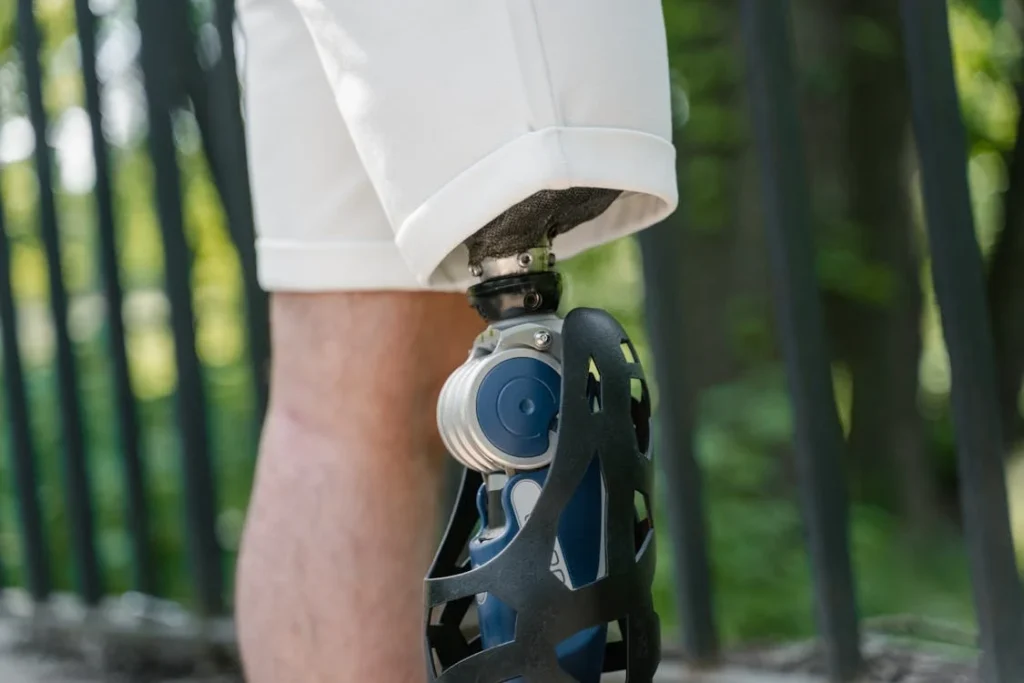Recovering from an amputation is a journey that requires strength, adaptation, and the right support systems. While the human body is incredibly resilient, modern technology has made rehabilitation faster, safer, and more effective than ever before. Today, advancements in prosthetics, smart rehabilitation tools, and AI-powered assistive devices are transforming how amputees regain mobility and independence.
Technology is not just about replacing lost limbs—it is about enhancing movement, improving comfort, and restoring confidence. From high-tech prosthetics that mimic natural motion to virtual rehabilitation programs that help train the brain, technology plays a key role in making recovery more efficient and empowering.
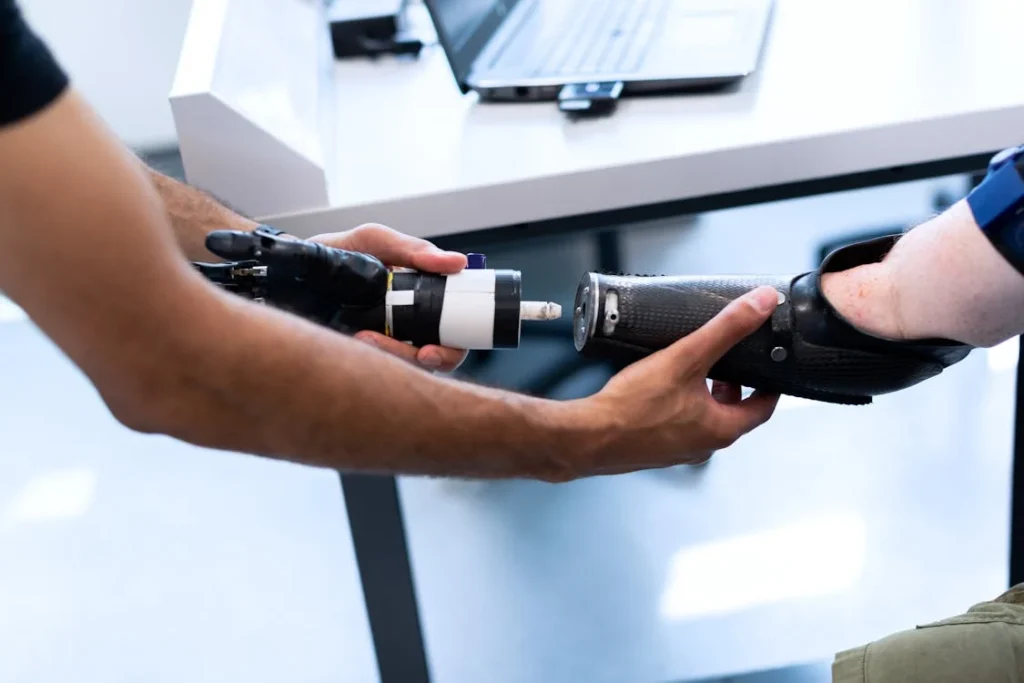
Advancements in Prosthetic Technology: Restoring Movement and Function
One of the most significant ways technology has transformed amputation recovery is through the development of advanced prosthetic limbs.
Unlike older prosthetics, which were often heavy and difficult to control, today’s prosthetic devices are lighter, smarter, and more responsive. They are designed to mimic natural movement, giving users a greater sense of control and confidence in their mobility.
Bionic Prosthetics and Artificial Intelligence
Bionic prosthetics have changed the way amputees interact with their environment. These devices use artificial intelligence (AI) and sensor technology to detect muscle signals from the residual limb.
This allows the prosthetic to respond almost instantly to a person’s intentions, whether they are reaching for an object, walking, or performing delicate tasks.
For example, myoelectric prosthetics work by sensing electrical signals from the muscles in the residual limb. These signals are then translated into movement, allowing the user to control their prosthetic hand or arm with natural ease.
Advanced versions of these prosthetics can even adjust grip strength, making it possible to hold a delicate object like an egg or a firm object like a suitcase without conscious effort.
Lower-limb prosthetics have also seen remarkable improvements. Microprocessor-controlled prosthetic knees are now capable of adjusting to different walking speeds and terrains, making movement smoother and more efficient.
These prosthetics use sensors to detect gait patterns and automatically adapt, providing better stability and reducing the risk of falls.
Lightweight Materials and Enhanced Comfort
Traditional prosthetic limbs were often made from heavy materials that could cause discomfort and fatigue. Modern prosthetics now use carbon fiber, titanium, and other lightweight yet durable materials, making them easier to wear for extended periods.
The goal is not just to provide functionality but to ensure that the prosthetic feels like a natural extension of the body.
Custom-fit sockets, which connect the prosthetic limb to the residual limb, have also improved significantly. Advanced 3D scanning and printing technology now allow for precise, personalized fittings, reducing pressure points and enhancing overall comfort.
A well-fitted prosthetic socket is crucial for preventing skin irritation and ensuring better mobility throughout the day.
The Future of Smart Prosthetics
The future of prosthetic technology is moving toward mind-controlled limbs and sensory feedback integration.
Researchers are working on prosthetics that can send signals back to the brain, allowing amputees to “feel” textures and temperature. This development will bridge the gap between artificial limbs and natural sensation, making prosthetic use even more intuitive and lifelike.
With ongoing advancements, prosthetics are no longer just about replacing what was lost—they are about enhancing what is possible. These innovations give amputees the ability to move freely, perform complex tasks, and regain their independence with confidence.
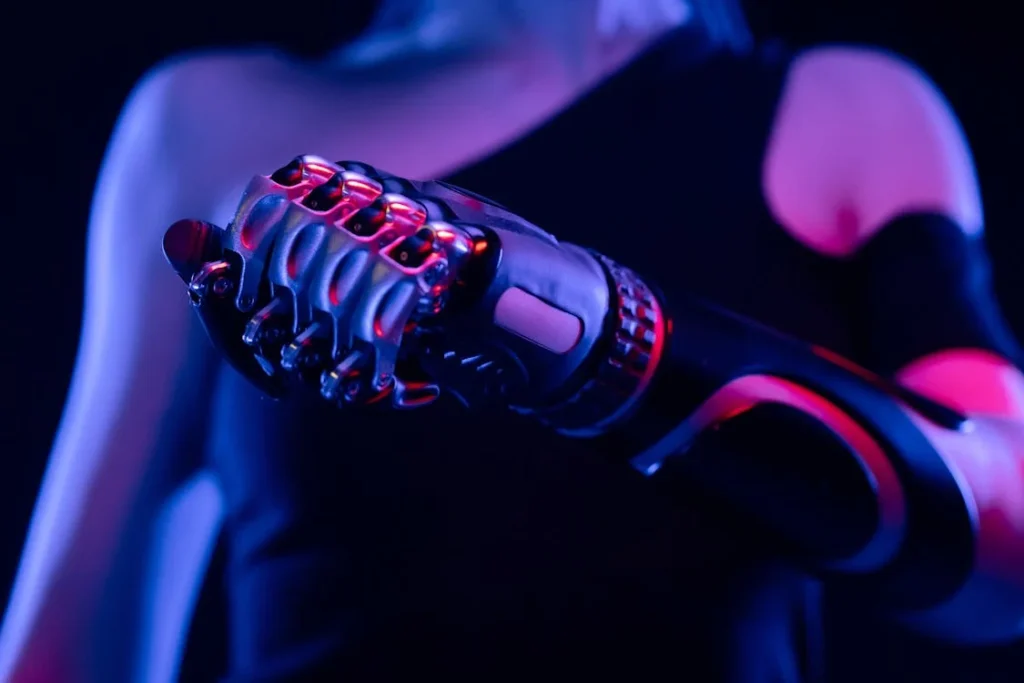
Smart Rehabilitation: How Technology is Improving Recovery
Recovering from an amputation is not just about getting a prosthetic limb—it is about retraining the body and brain to work together in new ways. Modern rehabilitation technology is making this process faster, more effective, and even engaging.
With the help of virtual reality, robotics, and AI-driven therapy programs, amputees can now rebuild strength, improve coordination, and regain confidence with innovative training methods.
Virtual Reality (VR) and Augmented Reality (AR) for Rehabilitation
One of the most exciting breakthroughs in rehabilitation is the use of virtual reality (VR) and augmented reality (AR). These technologies create interactive environments where amputees can practice movements in a safe and controlled way.
For example, VR-based therapy allows users to perform balance and coordination exercises in a simulated world. This helps train the brain to adapt to a prosthetic limb without the risk of falling.
It also makes therapy more engaging by turning rehabilitation into an immersive experience, reducing frustration and improving motivation.
AR, on the other hand, overlays digital elements onto the real world. Some rehabilitation programs use AR to guide users through exercises, providing real-time feedback on posture, movement, and weight distribution.
This ensures that movements are done correctly, reducing the risk of strain or injury.
Robotic Rehabilitation for Strength and Coordination
Robotic rehabilitation devices are also changing the way amputees regain mobility. These machines use precision-controlled movements to help patients rebuild strength in their residual limb.
They provide gentle, repetitive motion exercises, allowing users to regain control over their muscles while reducing stress on the joints.
For lower-limb amputees, robotic exoskeletons provide support during gait training, helping individuals learn to walk with a prosthetic limb while maintaining proper balance and posture.
These devices help retrain the body to move efficiently, making the transition to full mobility smoother.
Upper-limb amputees benefit from robotic therapy arms, which assist in improving grip strength, coordination, and fine motor skills. These systems track progress over time, allowing therapists to adjust rehabilitation programs based on real-time data.
Gamified Rehabilitation: Making Recovery More Engaging
One of the biggest challenges in rehabilitation is staying motivated. Traditional therapy exercises can feel repetitive and exhausting, leading to frustration.
To make rehabilitation more engaging, many programs now incorporate gamification techniques—turning exercises into interactive games that reward progress and encourage consistency.
For example, some therapy programs use motion sensors that track body movements and turn them into in-game actions.
An amputee practicing weight shifts or reaching exercises might control a character in a virtual world, making the experience fun while still improving balance and coordination.
AI-Powered Therapy and Personalized Recovery Plans
Artificial intelligence (AI) is making rehabilitation more personalized and efficient. AI-driven rehabilitation systems analyze movement patterns and provide real-time feedback, helping patients improve their technique while reducing strain.
These programs can also track progress and adjust difficulty levels, ensuring that therapy remains challenging but achievable.
Some AI-based platforms even allow amputees to perform guided therapy sessions at home, reducing the need for frequent clinic visits.
By combining machine learning, motion tracking, and customized therapy plans, these programs make rehabilitation more accessible and adaptable to individual needs.
The integration of technology in rehabilitation is changing the way amputees recover, making therapy more interactive, effective, and empowering.
These innovations help individuals regain strength, confidence, and independence, ensuring that they can move forward in life with greater ease.
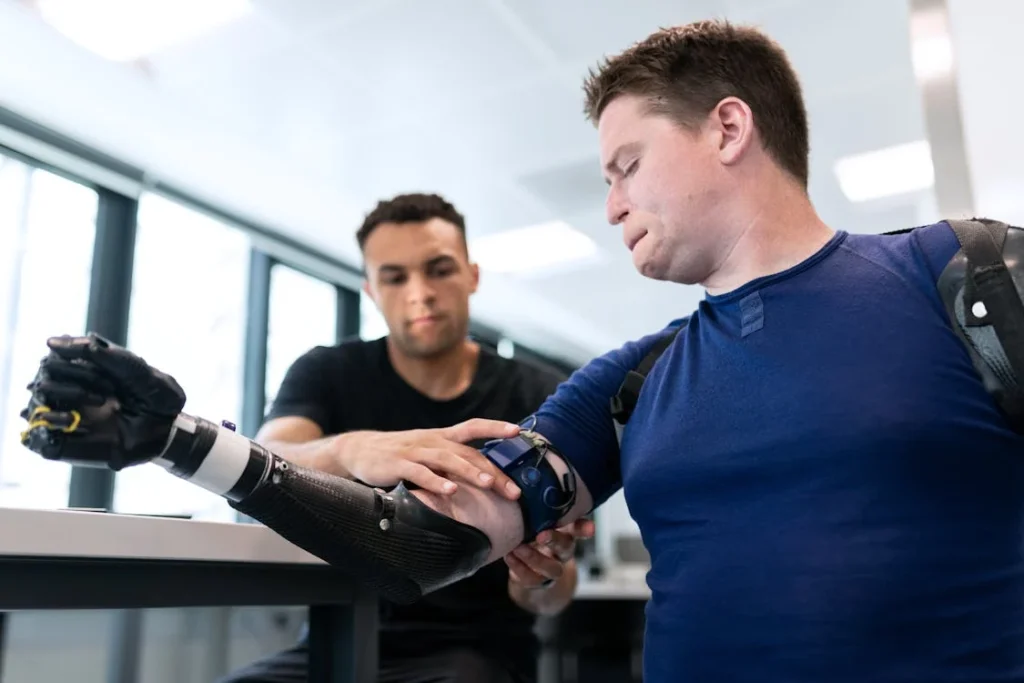
The Impact of AI and Smart Sensors in Amputation Recovery
Artificial intelligence (AI) and smart sensor technology are playing a transformative role in post-amputation recovery.
These advancements provide real-time feedback, improve movement accuracy, and enhance prosthetic performance, allowing amputees to regain natural mobility with greater efficiency.
By integrating machine learning, biomechanics, and sensor-driven adjustments, these technologies are making rehabilitation more precise and personalized than ever before.
AI-Driven Prosthetic Adaptation for Natural Movement
One of the biggest challenges for prosthetic users is adjusting to the way the limb moves. Traditional prosthetics required manual adjustments, making it difficult to achieve fluid and natural motion.
Today, AI-powered prosthetics learn and adapt to an individual’s movement patterns, providing a more intuitive experience.
These smart prosthetics use machine learning algorithms to analyze walking patterns, weight distribution, and muscle signals. Over time, the AI adjusts to the user’s preferences, making movements more comfortable and natural.
Some advanced prosthetic legs even come with real-time terrain adaptation, allowing users to walk on stairs, uneven ground, or slopes without needing to make manual adjustments.
By continuously refining movement, AI-powered prosthetics help users experience less fatigue, better posture, and greater stability, making everyday activities easier and more enjoyable.
Smart Sensors for Enhanced Balance and Gait Training
Regaining balance and coordination after an amputation is one of the most important aspects of recovery.
Smart sensors embedded in prosthetic limbs, wearable devices, and rehabilitation tools help monitor movement and provide instant feedback to both the user and their rehabilitation team.
For lower-limb amputees, these sensors track weight distribution, step length, and joint movement, helping users develop a more stable and efficient walking pattern.
If the system detects an imbalance, it provides gentle corrections in real time, guiding the user toward better posture and alignment.
Upper-limb prosthetics also benefit from grip strength sensors, which allow for precision control when holding objects.
These sensors help users develop better motor control, making everyday tasks—such as picking up a glass of water or typing on a keyboard—more natural and effortless.
Neural Interfaces: Merging the Brain with Technology
One of the most groundbreaking developments in prosthetic technology is the introduction of neural interfaces, also known as brain-controlled prosthetics.
These devices read signals from the brain and convert them into movement, allowing amputees to control their prosthetic limb as if it were part of their body.
Unlike traditional prosthetics that rely on muscle contractions, neural interfaces create a direct link between the brain and the artificial limb, enabling faster, more precise control.
This technology is still evolving, but early research shows promising results in restoring dexterity and sensation.
Some experimental prosthetics are even capable of sending sensory feedback to the brain, allowing users to feel texture, pressure, and temperature through their artificial limb.
As neural interfaces become more advanced, they will eliminate the gap between natural and artificial movement, giving amputees unprecedented control and functionality.
Real-Time Monitoring for Personalized Recovery Plans
Another significant benefit of AI and smart sensor technology is the ability to track rehabilitation progress in real time.
Wearable devices, smart prosthetics, and mobile health apps can monitor movement patterns, muscle activity, and overall mobility, providing instant feedback on progress.
Physical therapists and doctors can use this data to customize rehabilitation programs, ensuring that each individual receives the right level of training and support.
If a problem is detected—such as poor weight distribution, inefficient gait mechanics, or excessive strain on the residual limb—adjustments can be made immediately to prevent injury and enhance recovery.
By combining AI, sensor technology, and real-time analytics, amputees now have access to a smarter, data-driven approach to rehabilitation.
These advancements help create a personalized, responsive, and highly effective recovery experience, ensuring that individuals regain their independence as quickly and safely as possible.

The Role of 3D Printing in Prosthetics and Rehabilitation
One of the most exciting technological advancements in amputation recovery is the use of 3D printing. This innovation has revolutionized the way prosthetics are designed, making them more affordable, customizable, and accessible than ever before.
Traditional prosthetics often involve long production times and high costs, but 3D printing is changing that by offering fast, precise, and cost-effective solutions for amputees worldwide.
Customization for a Perfect Fit
Every amputee’s body is unique, which is why a custom-fit prosthetic is essential for comfort and functionality.
In the past, the process of creating a prosthetic limb involved multiple fittings and manual adjustments, which could be both time-consuming and uncomfortable. With 3D scanning and printing, this process has become significantly faster and more precise.
A digital scan of the residual limb is taken, and a perfectly shaped socket is created using 3D modeling software. This ensures a snug, comfortable fit, reducing the risk of pressure sores, irritation, or instability.
Since the entire design is created digitally, adjustments can be made easily without requiring multiple physical molds.
Affordable and Accessible Prosthetic Solutions
One of the biggest challenges for amputees, especially in developing countries, is the high cost of prosthetic limbs. Many individuals are unable to afford traditional prosthetics, which can limit their mobility and independence.
3D printing has made prosthetics more affordable, allowing more people to regain function without financial strain.
Because 3D-printed prosthetics are created with lightweight but durable materials, they are not only cost-effective but also comfortable for extended wear.
This is particularly beneficial for children, who often outgrow their prosthetic limbs quickly. Instead of having to purchase an entirely new device, a new, custom-sized prosthetic can be printed at a fraction of the cost.
Rapid Production for Faster Recovery
In traditional prosthetic manufacturing, the process of creating a limb can take weeks or even months. This delay can slow down rehabilitation, making it harder for amputees to adapt to their new way of moving.
With 3D printing, a prosthetic limb can be produced in just a few days, allowing individuals to begin their recovery much sooner.
This rapid turnaround time is especially valuable in post-surgery recovery, where early prosthetic use can help prevent muscle atrophy and improve mobility.
The quicker an amputee receives a well-fitted prosthetic, the easier it is to regain strength and confidence in daily activities.
Lightweight and Durable Materials for Comfort and Functionality
Traditional prosthetic limbs can sometimes be heavy and restrictive, making movement feel unnatural. 3D printing technology allows for the use of lightweight composite materials, making prosthetics more comfortable and functional for extended wear.
Some 3D-printed prosthetics even incorporate flexible joints and bio-inspired designs, mimicking the natural movement of muscles and tendons.
This provides better control, smoother motion, and greater adaptability to different activities, from walking and running to gripping and lifting objects.
Prosthetics for Different Needs and Lifestyles
Not all prosthetic users have the same needs. Some individuals require high-performance prosthetics for sports and physical activities, while others may need lightweight limbs for everyday use.
With 3D printing, prosthetics can be tailored to specific lifestyles, ensuring that each person gets the best possible mobility solution.
For example, an athlete might benefit from a prosthetic with a reinforced carbon-fiber structure for extra durability, while someone with a sedentary job might need a more lightweight, flexible design for all-day comfort.
This level of customization was once difficult and expensive, but 3D printing has made it possible to create highly specialized prosthetics with ease.
Future Innovations in 3D-Printed Prosthetics
The future of 3D-printed prosthetic technology is incredibly promising. Researchers are currently working on prosthetics with embedded sensors that can detect temperature, pressure, and grip strength, providing users with greater sensory feedback.
Other innovations include prosthetic limbs with built-in robotic components, allowing for even more precise movement and control.
With continued advancements in biocompatible materials, AI-driven designs, and user-friendly customization, 3D-printed prosthetics will continue to improve accessibility, comfort, and performance for amputees worldwide.
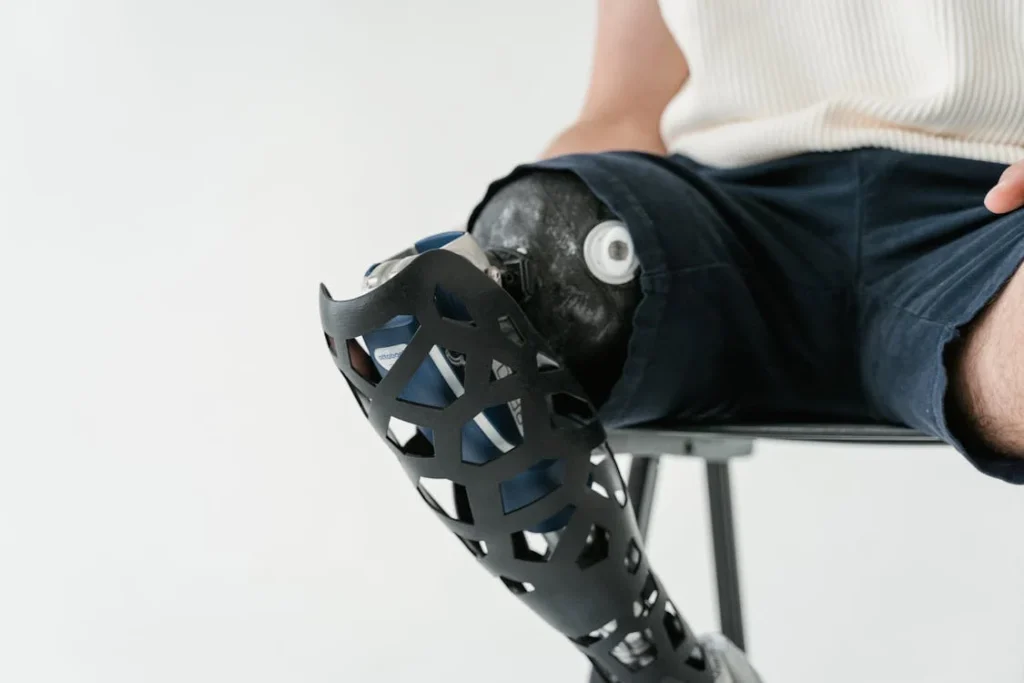
The Role of Smart Wearables in Post-Amputation Recovery
As technology continues to evolve, smart wearables are becoming an essential part of post-amputation recovery.
These devices, including smart prosthetic controllers, wearable motion trackers, and biofeedback systems, help amputees monitor their progress, improve mobility, and prevent common issues such as poor posture and muscle strain.
By collecting real-time data and providing instant feedback, smart wearables make rehabilitation more precise, efficient, and personalized.
Wearable Motion Sensors for Gait and Posture Analysis
One of the biggest challenges after an amputation is learning to walk or move with a prosthetic limb in a natural and balanced way.
Many amputees develop compensatory movements, such as leaning too much on one side or taking uneven steps, which can lead to joint pain and long-term mobility issues.
Wearable motion sensors help track an amputee’s movements in real-time, analyzing step length, weight distribution, and joint alignment.
These sensors, often worn on the prosthetic limb or remaining limb, send data to a smartphone or rehabilitation program. If an imbalance is detected, the system provides instant feedback, guiding the user toward better movement techniques.
By using wearable motion analysis, amputees can correct posture, improve walking efficiency, and reduce physical strain, making everyday mobility more comfortable and natural.
Smart Prosthetic Controllers for Enhanced Functionality
Some modern prosthetics are now integrated with smart controllers, allowing users to adjust settings and optimize performance through mobile apps or voice commands.
These controllers enable fine-tuning of grip strength, knee resistance, or step dynamics, depending on the user’s activity level.
For example, a prosthetic leg might automatically adjust for walking on stairs, uneven terrain, or different speeds, ensuring smooth and effortless movement.
Similarly, a bionic hand equipped with a smart controller can switch between different grip modes, allowing the user to perform delicate tasks like holding a pen or firm tasks like lifting heavy objects.
This level of control makes prosthetics feel more personalized and adaptive, enhancing both comfort and usability in everyday life.
Biofeedback Wearables for Muscle Rehabilitation
After an amputation, the residual limb often experiences muscle weakening and poor circulation, which can make prosthetic use uncomfortable and tiring.
Biofeedback wearables help stimulate muscle activity and improve strength, ensuring that the body remains active and responsive.
These devices use electrical stimulation and vibration therapy to engage muscles in the residual limb, preventing atrophy and stiffness.
Some advanced models even provide sensory feedback, allowing the brain to receive information about limb position, movement, and external pressure—which improves balance and coordination.
For upper-limb amputees, biofeedback gloves help train finger and wrist movement using subtle electrical pulses. This allows the brain to relearn hand functions, even when using a bionic prosthetic.
Smart Wearables for Pain Management and Comfort
Many amputees experience phantom limb pain, where the brain continues to send signals to a missing limb, causing discomfort and sensations of pain.
Smart wearable devices, such as nerve stimulation patches and sensory feedback bands, help manage this pain by disrupting the false nerve signals and retraining the brain to recognize the body’s new structure.
Temperature-regulating wearables also provide comfort by adjusting to the body’s needs, ensuring that the prosthetic limb does not become too hot or cold, which can lead to discomfort.
By integrating wearable technology into daily life, amputees gain access to real-time insights, better movement control, and enhanced rehabilitation techniques, ensuring a faster and more comfortable recovery journey.
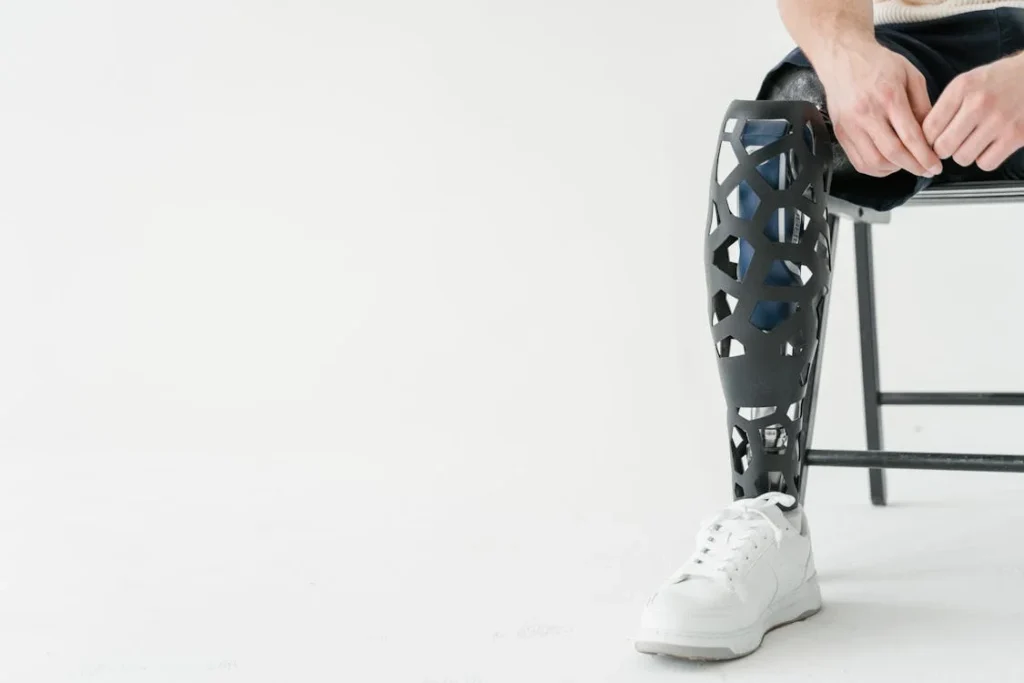
The Future of Amputation Recovery: AI, Robotics, and Regenerative Medicine
The field of amputation recovery is advancing rapidly, with emerging technologies pushing the boundaries of what is possible.
While prosthetics, smart wearables, and rehabilitation tools have already transformed recovery, the future holds even more groundbreaking innovations.
With advancements in artificial intelligence, robotics, and regenerative medicine, amputees may soon experience a level of mobility and sensory feedback that rivals natural limbs.
AI-Integrated Robotics: Merging Human and Machine
Robotic technology is advancing to the point where prosthetic limbs are no longer just static replacements—they are becoming intelligent extensions of the body.
AI-integrated prosthetics are learning to anticipate movement rather than simply reacting to muscle signals. These next-generation devices use predictive algorithms to analyze walking patterns, making real-time adjustments for better balance and efficiency.
For example, robotic legs equipped with machine learning software can detect changes in terrain, allowing users to walk effortlessly across stairs, inclines, or uneven ground without manual adjustments.
These prosthetics work in harmony with the body, making movements feel more natural and intuitive.
Similarly, robotic arms are evolving to grip objects with greater precision, using AI-powered sensors that detect pressure and shape. This allows amputees to hold fragile objects like a glass of water or grip heavier tools without needing to switch settings manually.
Sensory-Enabled Prosthetics: Restoring the Sense of Touch
A major challenge in amputation recovery has been the lack of sensory feedback from prosthetic limbs.
While current prosthetics provide mobility and function, they do not allow users to feel temperature, pressure, or texture—making everyday activities like adjusting grip strength or sensing the stability of the ground more difficult.
Researchers are now developing sensory-enabled prosthetics that connect directly to the nervous system. These advanced limbs send electrical signals to the brain, simulating the sensation of touch.
Some experimental models have successfully allowed users to feel the softness of fabric, the firmness of an object, and even slight temperature differences.
This breakthrough will transform the way amputees interact with their environment, bringing prosthetics one step closer to functioning like natural limbs.
Regenerative Medicine: The Possibility of Limb Regrowth
Perhaps the most revolutionary area of amputation recovery is regenerative medicine, which explores the possibility of stimulating tissue regrowth and nerve regeneration.
Scientists are currently experimenting with stem cell therapy, 3D bioprinting, and genetic engineering to encourage the body to rebuild lost limbs or restore nerve connections.
While this technology is still in its early stages, some studies have shown promising results in nerve regeneration, which could help amputees regain natural control over prosthetic limbs.
If successful, regenerative medicine could offer solutions that go beyond prosthetics, restoring lost function in ways that were once considered impossible.
Mind-Controlled Prosthetics: The Ultimate Fusion of Brain and Technology
Advancements in brain-computer interfaces (BCIs) are making mind-controlled prosthetics a reality. These prosthetics bypass traditional muscle signals and instead connect directly to the brain, allowing users to control their artificial limbs just by thinking about movement.
Early trials have already shown that amputees using BCI prosthetics can pick up objects, control grip strength, and perform complex movements with minimal effort.
The future of this technology aims to make prosthetic limbs as responsive as natural ones, giving users the ability to move instantly and effortlessly.
With AI, robotics, and regenerative medicine leading the way, the future of amputation recovery is incredibly promising. These innovations will not only improve mobility but also enhance quality of life, providing amputees with independence, confidence, and new possibilities.
Conclusion
Technology has transformed amputation recovery from a challenging journey into an empowering experience. Advancements in AI-driven prosthetics, robotic rehabilitation, smart wearables, and regenerative medicine are not just improving mobility but also restoring confidence and independence. Amputees today have access to cutting-edge solutions that allow them to move more naturally, comfortably, and efficiently than ever before.
At Robobionics, we are committed to leveraging these innovations to enhance the lives of amputees. Our Grippy™ bionic hand is an example of how advanced prosthetic technology can provide greater control and functionality, helping individuals reclaim their freedom with ease.
The future of amputation recovery is filled with limitless possibilities. With ongoing research in mind-controlled prosthetics, sensory feedback, and AI-powered rehabilitation, we are moving closer to a world where prosthetic limbs are seamlessly integrated with the human body.



